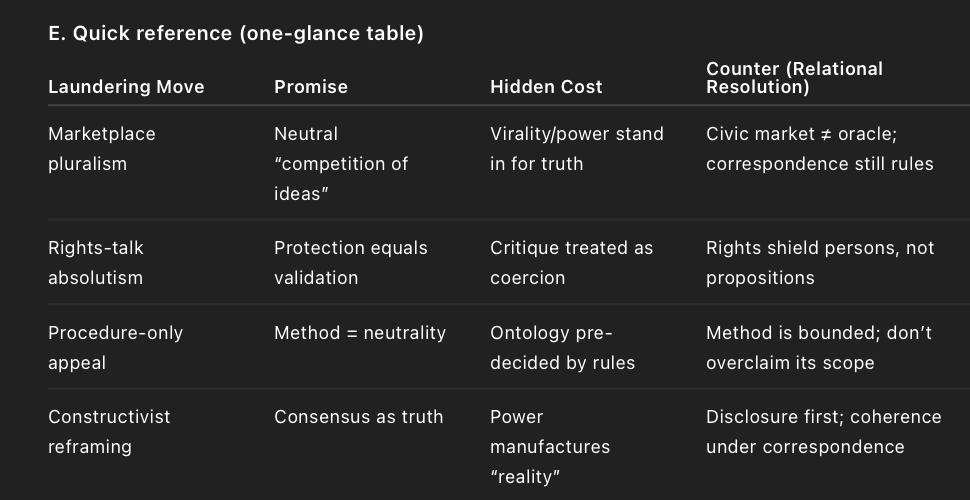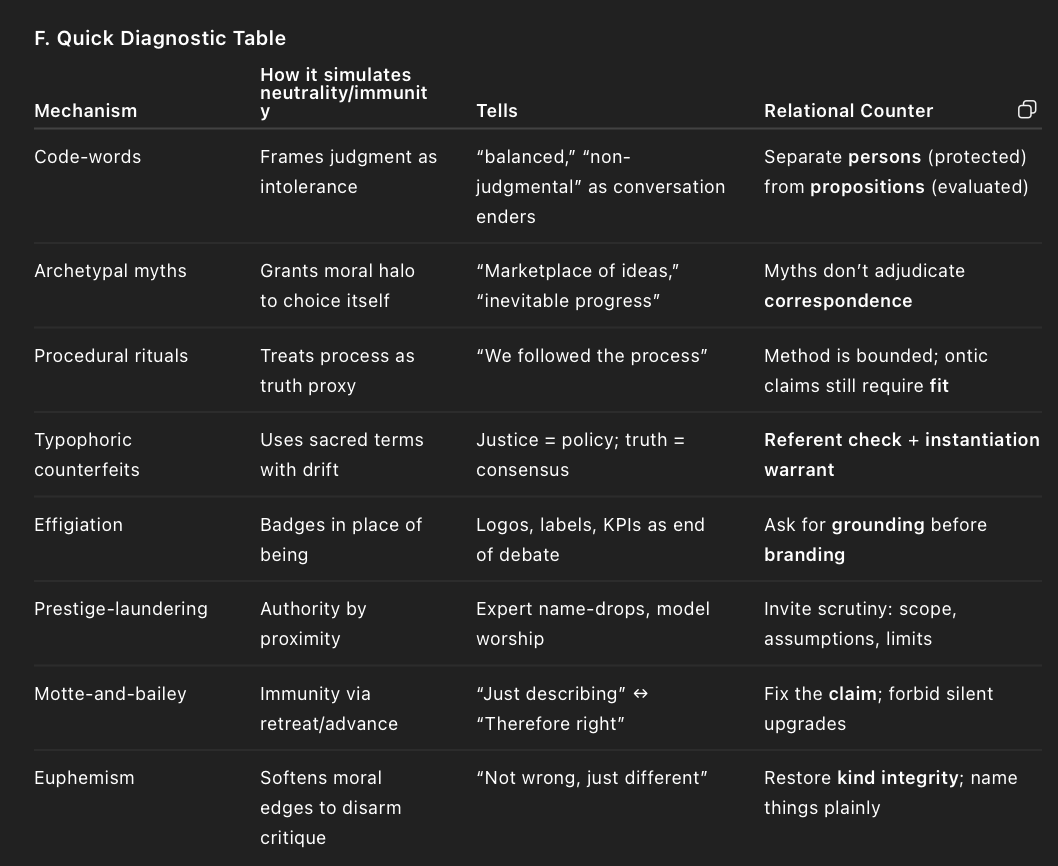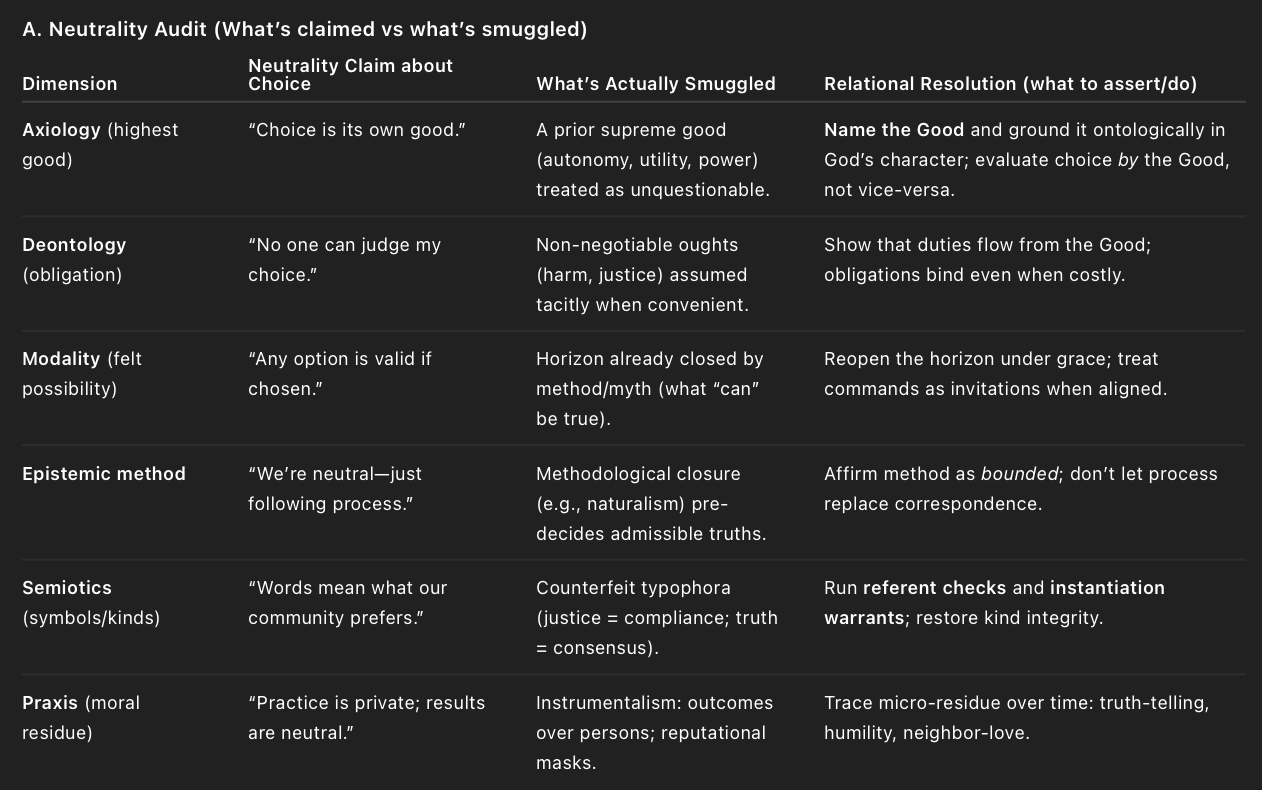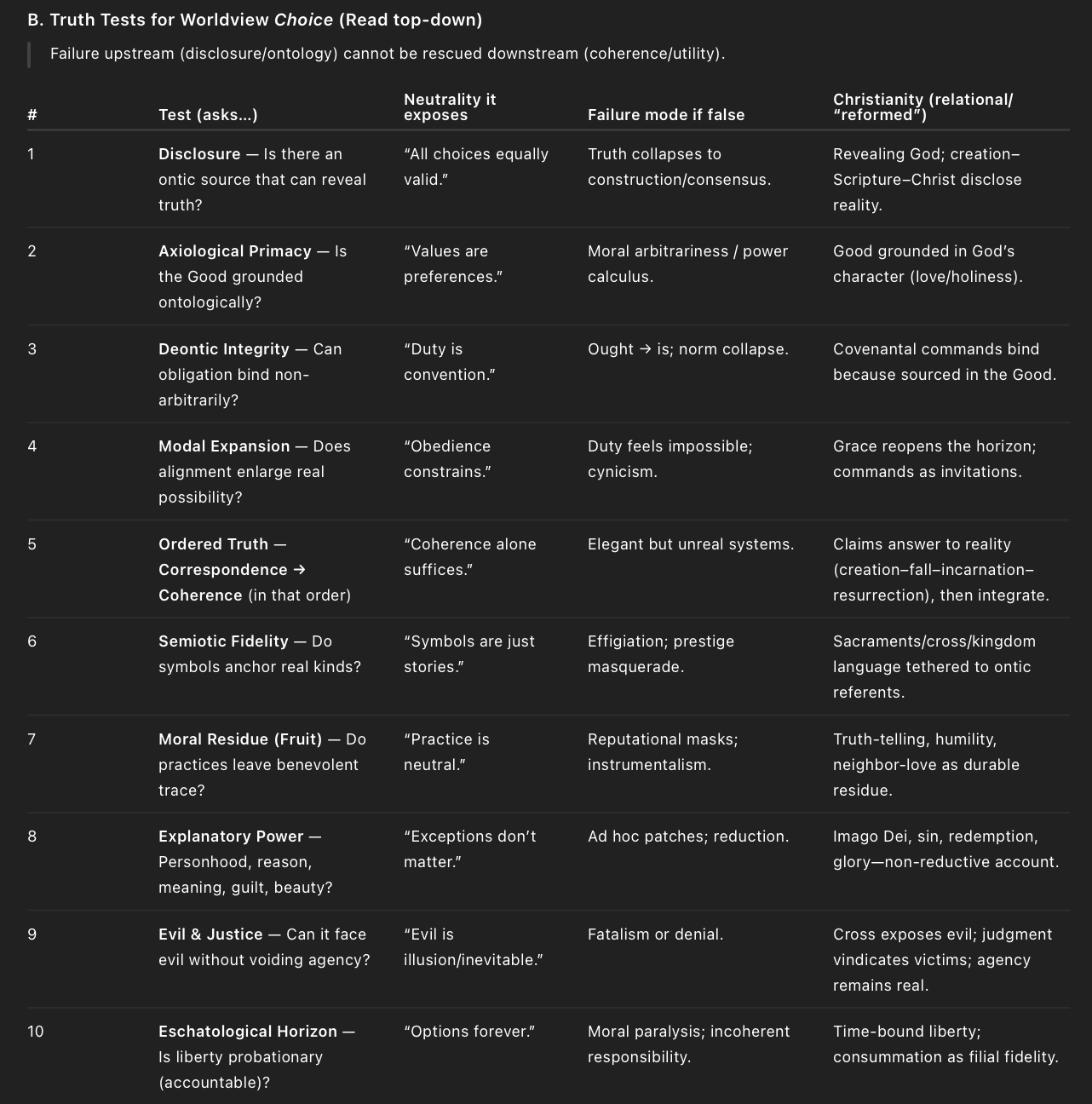Modern pluralism insists, “I have a right to my worldview.” As a civic statement, this protects persons from coercion; as an ontological claim, it smuggles a fiction — that choice is neutral before truth. In the relational frame, liberty of conscience is real but probationary: a time-bound gift under judgment. Worldviews are enacted allegiances tested by disclosed reality; rights do not sanctify falsehood, and neutrality does not shield consequence.
The result is a subtle category mistake. Civic tolerance belongs to the legal sphere and guards people; it cannot convert any proposition into truth or render all choices equivalent. Ontologically, truth confronts or invites irrespective of our votes. Non-response is response; postponement forms posture.
Thesis. There is no neutral right to choose a worldview. Civic protections remain valuable, but choice is accountable to disclosed reality, and worldviews are judged as allegiances, not indulged as preferences.
Liberty of conscience → probationary, accountable freedom (time-bound), not endless immunity.
Claim. The choice of a worldview does not arise from civic permission but from God’s prerogative to grant a real—yet time-bound—field of agency. Rights may protect choosers; they do not sanctify choices.
By the Divine Double Prerogative, as discussed in Ontology part 1 , God alone holds:
Liberty of conscience lives inside this frame: a God-given field in which allegiance is tested, not a humanly conferred immunity (cf. Deut 30:19; 2 Cor 5:10). It is real (so responsibility is meaningful) and probationary (so judgment is coherent).
Liberty of conscience is time-bound and accountable. It exists so that posture and allegiance can be revealed without coercion. To infer from civic tolerance that “my choice is therefore neutral” is a category error: protection of persons ≠ validation of propositions (Acts 17:30–31).
Every adopted worldview silently fixes positions across the Axiological–Deontic–Modal (ADM) unit, which then flower into Praxis. There is no neutral suspension at any point:
Implication. Declaring “I have a right to my worldview” does not keep these settings neutral; it merely hides that they have already been set.
Truth is relationally disclosed and then propositionally articulated. Conscience does not generate reality; it meets disclosed reality (see Moral Collapse and Taxonomic Recovery ). Hence, posture governs access, not existence: humility receives (invitation), autonomy resists (confrontation) (Rom 1:18–21; Acts 16:14; Luke 15:17).
Maxim. Rights may shield the chooser from coercion; they cannot shield the choice from reality.
Claim. Modern discourse quietly merges two different spheres: the civic (what law and policy should protect) and the ontological (what is true and what follows from it). This conflation produces the myth that a protected choice is therefore a valid choice. In your frame, these spheres must be distinguished without being divorced: the civic sphere protects persons from coercion; the ontological sphere judges propositions and postures before reality.
Maxim: Protection of persons ≠ validation of propositions.
Each move smuggles immunity from the civic sphere into the ontological one.

Legend:
Civic = who may speak/assemble; Ontological = what is; Pastoral = how agents respond to what is.
Civic example — arithmetic in public: A citizen declares “2+2=5.” The civic sphere should not imprison the speaker; protection of person holds. Ontologically, the claim remains false; engineering collapses if we pretend otherwise.
Protection does not transubstantiate error into truth.
Pastoral example — worldview deferral: “I choose expressive individualism; I have a right to it.” Civically protected.
But ontologically, the claim that the self authors meaning faces a disclosed order (creation, moral law, judgment).
Deferral is itself posture.
Non-response is response; delay trains the will and narrows perceived possibility (Rom 1:18–21).
Once spheres are rightly distinguished, we can ask how choices are experienced. The answer is posture: humility receives truth as invitation; autonomy resists it as confrontation. The felt neutrality of “just choosing” dissolves when we see that choice is already a posture exercised within a probationary field.
Summary: Civic tolerance is a good servant but a bad oracle. It shields who may choose; it cannot certify what they choose.
Claim. The felt “neutrality” of choosing a worldview is an illusion created by posture. The same disclosed reality is experienced as welcome or warning depending on the chooser’s noetic stance. Choice is already a posture; it cannot be neutral.
Maxim: Conscience does not create reality; it meets it. Posture decides whether that meeting feels like welcome or warning.

Within ADM , posture primarily deforms or enlarges Modality:
Repeated choices train posture:
Over time, posture leaves a moral residue in ordinary interactions:
Because posture shapes perception and practice, societies build cover stories to preserve the feeling of neutral choice. Next, we’ll see how “neutral choice” gets laundered—via marketplace pluralism, rights absolutism, procedure-only appeals, and constructivist redefinitions of truth.
Claim. Because choice is never ontologically neutral, societies develop cover mechanisms that make it feel neutral. These mechanisms launder accountability into immunity. Four recurrent moves do most of the work.
Pitch: A neutral marketplace of ideas lets everyone choose; truth will emerge by competition.
Smuggled premise: The “market” already encodes an axiology (what counts as good reasons, who counts as a knower, which voices get reach).
Hidden cost: Real goods (truth, persons) are subordinated to market goods (attention, virality, coalition power).
Counter: Protection of persons ≠ validation of propositions. The civic market is a prudential arrangement, not an oracle of truth. Worldview choice remains accountable upstream.
Mini-example: A platform boosts “balanced” takes because they drive engagement. A claim’s visibility is taken as plausibility. But reach≠ reality; the algorithm is not an epistemic referee.
Rhetorical tell: Appeal to “both sides” as a substitute for correspondence to reality.
Pitch: If my view is legally protected, it must be socially validated.
Smuggled premise: Civic protection bestows epistemic warrant.
Hidden cost: Truth assessment is chilled; criticism is mistaken for coercion.
Counter: Rights restrict force against persons; they do not confer truth on propositions. Liberty remains probationary, time-bound, accountable.
Mini-example:“We must teach worldview X alongside Y for balance.” Civic inclusion is confused with ontological equivalence. Curricular parity is not a truth test.
Rhetorical tell: “Silencing!” used to deflect scrutiny that isn’t coercive.
Pitch: We don’t take sides; we follow the method.
Smuggled premise: The method is ontologically agnostic (e.g., methodological naturalism = “just procedure”).
Hidden cost: The procedure fixes the ontological field in advance (what may count as evidence, which causes are admissible). Closure masquerades as neutrality.
Counter: Method is good as method, but it is not ontologically blank. Where the method closes the horizon (e.g., excludes non-material causes in principle), its outputs cannot claim metaphysical neutrality.
Mini-example: A policy board says, “Our framework forbids discussing final causes.” Then reports, “There are no final causes.” The conclusion is baked into the rule.
Rhetorical tell: “We’re just being objective” used to terminate—not invite—first-order questions.
Pitch: Truth is a social product; coherence within a community is the test.
Smuggled premise: Disclosure is denied; correspondence is replaced by consensus.
Hidden cost: Power arbitrates reality; dissenters are pathologized or expelled.
Counter: Knowledge is relational first, propositional by disclosure. Communities receive or resist reality; they don’t constitute it. Coherence is valuable under correspondence, never as a substitute.
Mini-example: A discourse coalition declares a category “real” by fiat; sanctions enforce usage. The sign is severed from the kind (effigiation). Language moves, but ontology hasn’t.
Rhetorical tell: “Our lived reality defines reality”—without any test beyond agreement.

Maxim: Immunity mechanisms trade on a category error: they move civic protections and procedural rules into the truth domain as if that could neutralize consequence.
Bridge to next section: These laundering moves don’t float in air; they’re built and maintained by semiotic engines—codes, myths, narratives, and typophoric gestures that simulate ontological legitimacy. Next: how immunity is enforced semiotically (typophora, effigiation, prestige-laundering). See also glossary .
Claim. The feeling that worldview choice is neutral is not spontaneous; it’s manufactured. Societies deploy semiotic engines—codes, myths, narratives, rituals—to launder choice into apparent immunity. These engines simulate ontological legitimacy without securing it. Semiotics is discussed in more detail elsewhere in the framework.
Code → Myth → Narrative → Ritual → Policy
Codes (lexicon & frames): Terms like balanced, objective, non-judgmental, evidence-based, inclusive of perspectives set a “neutral” tone.
Effect: primes readers to treat disagreement as intolerance rather than adjudication.
Myths (archetypes): Marketplace of ideas, science is neutral, progress is inevitable.
Effect: grants moral halo to “choice,” recasting critique as regression.
Narratives (plots with heroes/foils): The open-minded chooser vs the dogmatist; the pragmatic reformer vs the absolutist.
Effect: positions accountability as vice, optionality as virtue.
Rituals (repeatable acts): Peer-review as talisman, stakeholder consultations, balanced panels, “both-sides” segments.
Effect: confers procedural sanctity irrespective of ontological fit.
Policies (hardening): Content-neutral guidelines that quietly privilege one ontology (e.g., methodological closures) while claiming only “process.”
Effect: immunizes the chosen frame from first-order scrutiny.
Effigiation: Creating look-alike forms of authority—badges, labels, metrics—that mimic ontological grounding.
Examples: “Evidence-based™” stamped on methodologically closed claims; “peer-reviewed” as an untouchable end-state rather than a fallible filter; “consensus = truth.”
Pseudo-Instantiation: Treating a construct as if it were a real kind (e.g., redefining personhood, marriage, or justice by policy fiat), then demanding moral deference to the construct.
Symptom: Punishing mis-naming more than misconduct; language policed while referents drift.

Semiotic enforcement explains why neutral-choice feels plausible. The next step is evaluation: a neutrality audit for what’s being smuggled, and a set of truth tests (ordered correspondence → coherence → pragmatics) that show, positively, why civic protection of choosers does not—and cannot—sanctify their choices.
This section helps to test the claims that “my choice of worldview is neutral.” The first table surfaces what’s being smuggled under neutrality talk; the second applies ordered truth tests (correspondence → coherence → pragmatics) and shows, positively, how a relational/“reformed” Christian frame passes.

Legend.
“Smuggled” = hidden value/duty/method that pre-judges truth. “Resolution” = what your framework asserts and how to test it in practice.

A valid choice must pass disclosure before coherence, ground good before duty, expand possibility under grace, and leave a benevolent residue that fits reality over time.
These diagnostics show why “my right to choose” does not neutralize consequence: rights protect choosers; tests adjudicate choices. Next we apply the grid to concrete frames (expressive individualism, technocratic utilitarianism, naturalism, civil religion, prosperity gospel) and then address common objections without collapsing civic tolerance into truth validation.
How to read this: Each case shows (1) the claim and the neutral-choice story it tells, (2) a diagnosis using ADM + semiotics + laundering moves, and (3) the relational resolution. Use the rhetorical tells to spot them in the wild.
Claim / Neutral-choice story. The self authors meaning; authenticity sanctifies preference. Civic protection becomes ontological immunity: “I have a right to be who I say I am; therefore you must treat my choice as valid.”
Diagnosis (ADM + semiotics).
Rhetorical tells. “Affirm me or you deny my existence.” “Lived experience is decisive.”
Relational resolution. Personhood is received, not self-made; love is benevolent other-regard under truth, not unconditional approval. Grace expands possibility so obedience is invitation, not erasure. Test by moral residue: truth-telling when costly, quick confession, durable charity.
Claim / Neutral-choice story. Procedures and metrics are value-free; the optimal (max-utility) choice is thereby neutral and justified.
Diagnosis (ADM + semiotics).
Rhetorical tells. “We followed the process.” “The data prove…” (beyond the data’s scope).
Relational resolution. Honor method as bounded tool; do not let it replace correspondence. Ground the good in God’s character; treat persons as ends, not units. Audit by badge removal: does the argument stand without logos and KPIs?
Claim / Neutral-choice story. Methodological naturalism is “only method,” so the choice to exclude non-material causes is neutral; conclusions are worldview-free.
Diagnosis (ADM + semiotics).
Rhetorical tells. “No evidence for X” where the framework forbids such evidence by rule.
Relational resolution. Keep method where it excels, but acknowledge ontological scope. Reopen disclosure: creation, Scripture, Christ. Apply Ordered Truth test (correspondence → coherence), Explanatory Power (reason, guilt, beauty), and Evil & Justice without voiding agency.
Claim / Neutral-choice story. The state’s non-sectarian “values” are neutral; majority/legal status confers moral legitimacy. Choosing the state creed is neutral and right “for the common good.”
Diagnosis (ADM + semiotics).
Rhetorical tells. “Unifying values.” “Harm to social fabric” used to silence principled objection.
Relational resolution. Distinguish protection of persons from validation of propositions. The state’s competence is civic peace, not ontological adjudication. Preserve probationary conscience without granting content infallibility to policy.
Claim / Neutral-choice story. Faith-choice is neutral and positive by definition; blessing follows mechanically. Critique is unbelief; choice is immunized by testimony and verses abstracted from context.
Diagnosis (ADM + semiotics).
Rhetorical tells. “Sow this seed now and unlock…” “Touch not the Lord’s anointed” to deflect scrutiny.
Relational resolution. Re-anchor goods in God’s character and cross-shaped discipleship; restore eschatological horizon (now/near/not-yet). Test by moral residue: truth, humility, generosity when unseen, not platformed.
Bridge to next section. With patterns visible, we can now meet the standard objections without collapsing civic tolerance into truth validation: “Isn’t this illiberal?” “Who decides truth?” “Aren’t we in a presuppositional standoff?” “Doesn’t this invite authoritarianism?”
Claim. The critique of “neutral choice” is often mistaken for an attack on liberty. It isn’t. We protect persons robustly while refusing to baptize propositions as true merely because they are protected.
Objection. If you deny neutrality of choice, aren’t you rejecting liberal tolerance?
Reply. No. ?
We affirm civic tolerance (protect persons from coercion) and deny ontological neutrality (truth remains adjudicable). Rights restrain force; they don’t certify content.
Guardrail. Policy: content-neutral protections for speech/assembly; culture: content-full evaluation of claims.
Objection. Without neutrality, truth becomes whoever has power.
Reply. Power is precisely what neutrality myths hide. Our tests are ordered and public: Disclosure → Axiology → Duty → Modality → Praxis → Residue.
These do not require a central arbiter; they invite scrutiny over time.
Practice. Publish assumptions, invite counter-evidence, examine moral residue in the open.
Objection. Every worldview starts somewhere; stalemate.
Reply. True that starting points exist; false that they’re equal.
Apply the tests: Which starting point (a) allows disclosure, (b) grounds good non-arbitrarily, (c) preserves obligation without coercion, (d) expands possibility under grace, (e) yields durable benevolent residue? The circle anchored to reality is not the same as a circle free-floating in consensus.
Objection. If claims can be judged false, won’t institutions force conformity?
Reply. Distinguish ontological judgment from institutional coercion. We refuse coercion of belief (probationary conscience), even as we evaluate beliefs.
Guardrails:
Objection. Smart people disagree; evidence underdetermines.
Reply. Exactly why we use ordered tests and residue over time. Coherence alone is insufficient; look for correspondence and fruit. Persistent inability to produce benevolent residue undercuts plausibility even when debate persists.
Objection. Strong critique makes minorities unsafe.
Reply. Coercion targets persons; critique targets propositions. Conflating them is a laundering move (rights-talk absolutism).
Practice. Civility toward persons; rigor with claims. Protect speakers; press arguments.
Objection. To live together, we must treat all views as equally valid.
Reply. Pluralism requires procedural peace, not epistemic relativism. Societies remain livable when they separate protection from validation and keep truth-seeking institutions open to challenge.
Objection. You stacked the deck for Christianity.
Reply. The column is a worked example, not a presumption. Any frame is welcome to the same scrutiny. If another view can (a) pass disclosure before coherence, (b) ground good before duty, (c) expand possibility without denial, and (d) leave benevolent residue across time and contexts, show it.

With objections addressed, we can talk practice: how to engage charitably and incisively—rhetorical tools, axiology-first questions, and community habits that keep civic protection strong while pursuing ontological truth.
Aim. Keep civic protection strong while pursuing ontological truth. Separate persons (protected) from propositions(evaluated). Make the hidden “neutral choice” moves visible, then invite ordered scrutiny.
Spot laundering moves (marketplace pluralism, rights-absolutism, procedure-only, constructivism).
Note code-words: balanced, inclusive, non-judgmental, evidence-based used as conversation enders.
Diagnose
Run the Neutrality Audit and Truth Tests (top-down: disclosure → axiology → duty → modality → semiotics → residue).
Identify which ADM settings are being smuggled.
Act
Reframe with the rhetorical grammar above.
Propose ordered tests and a time-bound residue check (“Let’s revisit in 6 months and compare fruits.”).
Keep civic safeguards explicit while pressing the truth question.

Civic tolerance is a good servant, not a truth oracle. It protects persons from coercion; it does not sanctify propositions. The claim “I have a right to my worldview” belongs to the civic sphere, but the choice itself is not neutral before reality. In the relational frame, liberty of conscience is real yet probationary: a time-bound, accountable freedom within which posture is revealed — humility receives truth as invitation; autonomy encounters it as confrontation.
The mechanisms that make choice feel neutral — marketplace pluralism, rights-absolutism, procedure-only appeals, constructivist reframing, and their semiotic supports — are laundering moves, not adjudications. Against them we set ordered tests (disclosure → axiology → duty → modality → coherence → residue) and public scrutiny over time. On these tests, Christianity (reformed, relational–propositional) claims not immunity but correspondence and fruit.
Charge. Keep persons protected and claims examinable. Name the highest good, state your duties, reopen possibility under grace, restore kind-integrity in your language, and track the moral residue your practices leave. Rights may shield the chooser; they cannot shield the choice from truth.
Series link-out. This chapter completes the arc set by the
Liberty of Conscience
essay and should be read alongside:
Myth of Neutral Culture
· Myth of Neutral Expression
· Myth of Neutral Origins
.
